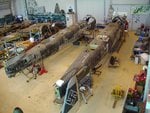Adlertag1940
Recruit
Does anyone know the specific differences regarding these Junkers variants. My understanding of the A-1(aside from the fact that it is rare for any military force to stick with any first variant for any extended period of time) was that its engines were considered problematic so a switch was made and thus the A-4 which did not appear in any significant amount during the Battle of Britain. But i had also read that the wingspan was a few feet shorter than later variants? Is this true as well? Any help is greatly appreciated.
Thanks, Mike
Thanks, Mike

